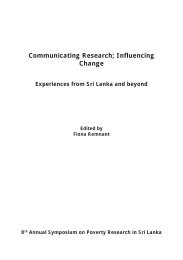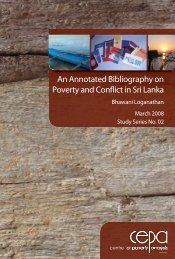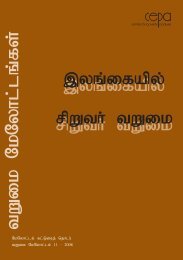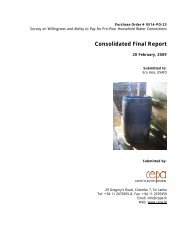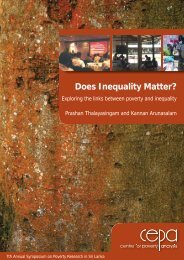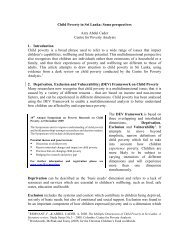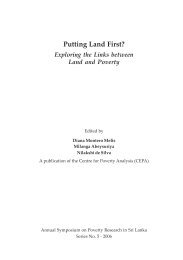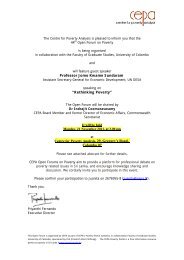Involuntary Displacement and Resettlement â Policy and ... - CEPA
Involuntary Displacement and Resettlement â Policy and ... - CEPA
Involuntary Displacement and Resettlement â Policy and ... - CEPA
- No tags were found...
Create successful ePaper yourself
Turn your PDF publications into a flip-book with our unique Google optimized e-Paper software.
implication is that relief efforts will have to persist for a longer period if thedisplaced persons were to be taken beyond NR 1to NR, movement along thepath R from C to C 1taking additional time.3 <strong>Displacement</strong> of People in Sampur, Sri LankaSince 1956 Sri Lanka has experienced several bouts of ethnic violence. Theworst of these came in 1983, resulting in the deaths of nearly a thous<strong>and</strong>civilians of Tamil origin. Between 1983 <strong>and</strong> the date of writing, ethnicviolence has escalated into a civil war waged between the Government of SriLanka <strong>and</strong> the Liberation Tigers of Tamil Eelam (LTTE). The violence in 1983made a large number of Tamils flee the country. The flow of refugees, boundmainly to India, Western Europe, Canada, Australia <strong>and</strong> New Zeal<strong>and</strong>,though varying at times, continues unabated at the time of writing. Theconflict in Sri Lanka has also produced IDPs, whose livelihoods are the focusof this paper. The expulsion of nearly 75,000 Muslims from the NorthernProvince, mainly from Jaffna <strong>and</strong> Mannar districts, by the LTTE in 1990, isgenerally considered the origin of the IDP problem in Sri Lanka. IDP numbersin Sri Lanka vary widely, depending on the source of information <strong>and</strong> theperiod for which the estimation is made. The number is also sensitive to theintensity of the conflict (van Brabant 1998).With the recent intensification of the conflict in the Vanni, Northern Province,the issue of IDPs has come to the fore in a forceful manner. Ironically aprocess of resettlement <strong>and</strong> relocation of IDPs is also going on − sometimesin the same regions that are generating IDPs. For instance, UNHCR (2007)reports that 99,265 IDP families returned to their homes during the 2002-2004 period when the Norwegian brokered ceasefire agreement (CFA)between the government <strong>and</strong> the LTTE was being honoured by both signatories.During this period new displacements were minimal (UNHCR 2000). In2006, the IDP situation was more complex: while some IDPs were returning,large numbers of fresh displacements were taking place elsewhere in thecountry (UNHCR 2007). Going beyond the issue of the numbers of IDPs,other issues such as whether returnees are doing so voluntarily, <strong>and</strong> whenan IDP ceases to be one, are also important in the Sri Lankan context (Brun2003). These issues, however, are beyond the scope of this paper.The people of Sampur were displaced in five phases until they reachedBatticaloa. Amirthalingam <strong>and</strong> Lakshman (forthcoming) provide adetailed discussion about the process <strong>and</strong> phases of displacement of63



